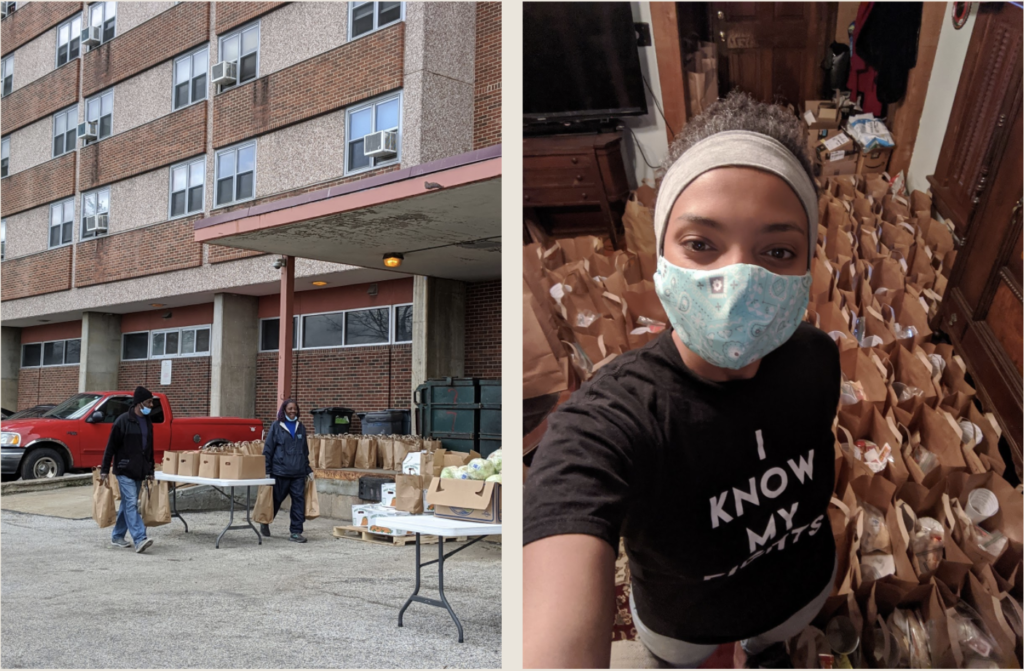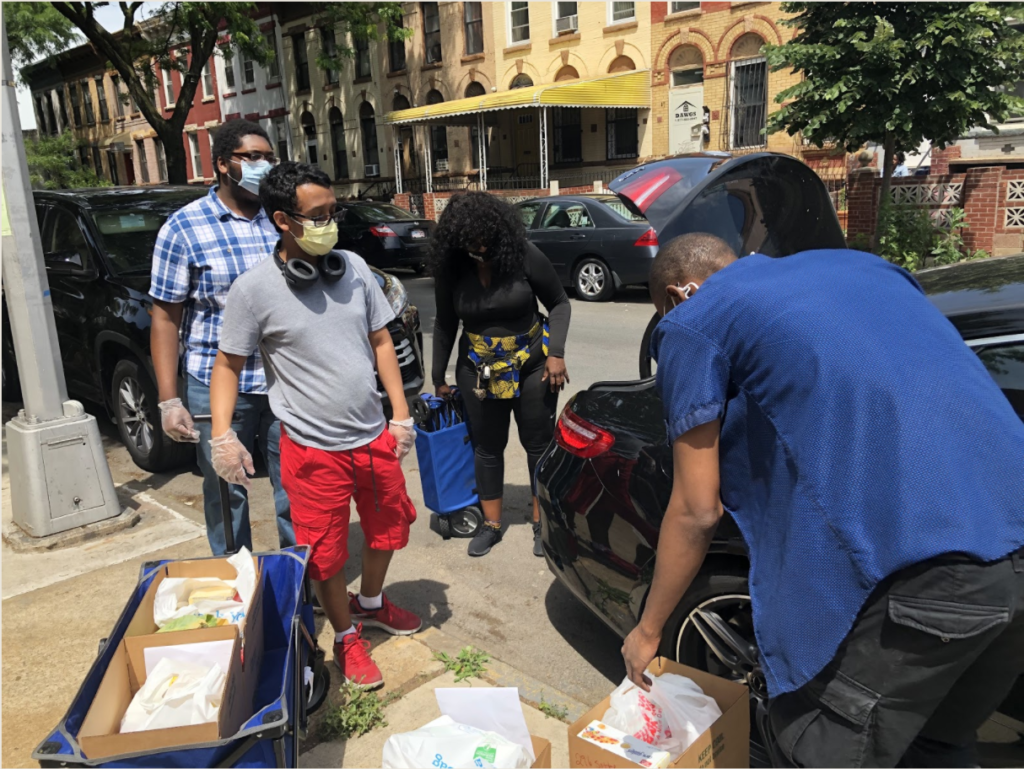Are you looking for a way to help your neighbors, but not sure where to begin? Figuring out what your community needs might sound like an intimidating task, but it doesn’t have to be–we promise! At ioby, we believe in the power of everyday folks (just like you) doing small things to create big change. That’s why we’re here to support you at every step along the way!
Recently, we interviewed some ioby neighbor leaders about how they organized for change in response to COVID-19—check out the full webinar here—and they had valuable insights to share. We’ve incorporated some of their lessons into three different approaches you can take to determine what your community needs right now. While all of these are important parts of the process, any of them makes a great first step!
One: Start where you are.
You’re an expert on your neighborhood, after all you live, work and play there! So maybe you’ve already noticed a need and have an idea for how to address it. If you don’t have an idea yet, that’s ok! Just by being a change-minded resident of your community, you’ve got the background knowledge and gut instincts you need to take action.
If you’re looking to find a focus for a project, we’ve got some suggestions for things you can consider. Since COVID-19 is a health-related crisis, you could start by thinking about the broader overall health of your community. Remember that while things like doctors visits are critical to health, there are other things that impact our health a lot too, like access to the outdoors and fitness activities, affordable healthy food, and more.
Think about your neighborhood. Do some of you or your neighbors face barriers when trying to access health and safety resources, like language barriers? Are the outdoor spaces near you well-maintained and accessible to everyone? Do folks have outlets to help support their mental health in times of social isolation? When you ask yourself questions like these, you might land on an idea for how to make your community a healthier place for all.

To help you think deeply about the health inequities that might exist in your neighborhood, we’ve put together a healthy communities toolkit to help you walk through that process. In addition to some guiding questions, it also contains advice from other ioby leaders who have built a culture of health in their communities. We recommend taking a look at this guide in the early stages of your planning, but it can also be a helpful resource throughout all stages of your project!
Two: Start by asking.
According to the CDC, seniors aged 65 and older are one of the highest-risk groups for contracting COVID-19 and experiencing complications as a result. But they’re also more likely to experience the debilitating psychological effects of loneliness from isolation. Malaz E and Angelo T, leaders of the Ohio City Riverview Care Package project, wanted to make sure the residents of a local senior care facility knew that they were valued and important members of their community.
As a group, they had already planned to deliver care packages containing food, but they wanted to make sure they didn’t miss anything critical. So they used one of the oldest (and most effective) techniques in the book: they simply asked!
By taking the time to find out firsthand what would make the residents feel valued, Malaz and Angelo were able to provide them with something that enriched their quality of life: activities to keep their minds busy. So the group group started including crosswords and other fun puzzles in the care packages. As Malaz puts it, they were able to treat the residents with dignity; in their own words, that meant “to be heard, to be seen, and to feel part of the community.”

At ioby, we believe that everyone is an expert on their own experience, so the simple gesture of asking your neighbors what they need is a powerful, easy, and straightforward way to start or deepen the impact of your project. You might choose to talk to your neighbors one-on-one, or you can reach groups of people through formal or informal needs assessments. No matter how you collect input from your neighbors, the important thing is that their concerns are heard and addressed.
Even though COVID-19 is making it difficult for many of us to gather in person, there are lots of ways you can still reach your neighbors. You might opt to drop notes on doorsteps, submit a letter to a community newspaper, or use social media to ask for input. All of these are ways to get to know what your neighbors need while still allowing you to stay safe.
If you’re interested in conducting a more formal needs assessment, this guide from the University of Minnesota is a great resource to have on hand. It contains lots of helpful information and step-by-step procedures for how to conduct research. It even includes specific questions and sample surveys you can start using right away! We found it so helpful that we’ve incorporated it into our healthy communities toolkit.
Three: Start with who you know.
If you know other people around you who are also looking for ways to help, why not start by deciding to work together? Each of us has a unique set of skills, perspectives, and connections, and teaming up with others is a great way to maximize the impact of our work.
You don’t have to start from scratch, either! You might want to consider partnering with other local organizations. Once you have a project idea, you could reach out to those who are doing complementary work or who could help you increase the scope of your operations. Are there other nonprofits around you who can help you achieve your goals?
On the flip side, you could also start by thinking about how you could help an existing organization. Do you have the resources or skills they might need, such as a car to make deliveries or the ability to translate information into another language? Reach out to other project leaders to see if they could use your helping hand!

Take it from Sharon S, leader of the Ocean Hill Brownsville Mutual Aid project. She says the people her community have always looked out for one another, and she saw how COVID was putting an extra layer of strain on her neighbors. “We noticed that they were struggling because of COVID, but also everything else in their lives.” When her group was just starting out, they joined forces with an existing organization in her area and started buying and delivering groceries to people for free. “It’s a simple and effective neighborhood response to the need we see,” she says. As Sharon and her neighbors remind us, we’re stronger when we work together!
Remember, things will change, and that’s okay!
We all know the situation surrounding COVID-19 is changing rapidly. As you’re organizing your project, you might discover that part of it is no longer necessary or needs to be adapted to fit the particular situation in your community. But that doesn’t change the fact that your work is important! Don’t be afraid to adjust your plans along the way.
Angela M, the ioby leader of Cleveland Art Week, was planning on hosting an art walk but cancelled it to comply with her local health and safety guidelines. However, she knew that kids still needed access to art. So she pivoted her strategy and started raising money to deliver art kits to their homes instead. Because she was willing to adjust her plans, Angela still found a way to serve her community. She’s a great example of how a leader can be flexible to stay resilient—and continue to get good done!
As you take your first steps in planning your project, remember: it’s okay to start small! You don’t need to know everything in order to begin; you’ll gain confidence and skill as you go along. Your natural strengths (and the strengths of your team members) will start to emerge, and you’ll figure out what works best for you and your neighborhood. Just as every community is unique, there’s no one-size-fits-all approach for how to organize for change!
When you’re ready to get started, we’d love to support you and your neighbors! Check out our resources for offering care during COVID-19 for more information about starting your project and getting your funds matched! Then, share your project with us at ioby! We can help you build a fundraising plan that’ll raise the funds you need to bring your idea to life